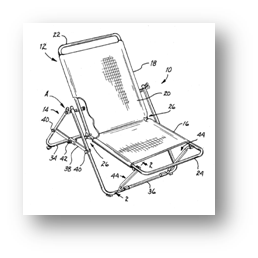
In 2002, Monit – an individual inventor – approached FQ with his idea for personal exercise equipment. FQ agreed to a confidentiality & nondisclosure agreement, but FQ eventually walked away from the deal.
In 2003, FQ began making the now-popular “Ab Lounge” and Monti sent a letter accusing the company of infringement and breach of the confidentiality agreement. FQ quickly filed for declaratory relief.

Disclaimed Needed Scope: Claim construction focused first on the term “back extension” in the apparatus claims. Monti argued that “back extension” could include pushing back in the Ab Lounger. The court rejected that argument because Monti’s application specifically disclaimed 
From the patent: “Many Nautilus TM type machines have been constructed in the prior art to mimic this movement and add resistance to it, biomechanically, the core movement of this type of machine was a pushing movement. This is a distinct disadvantage of the prior art methods of back extension. Also, this does not fall within the scope of Kinesiologically Correct TM [i.e., this invention].”
One of the asserted claims (claim 28) does not, however, include the back extension limitation. Apparently, the disclaimer only applies to the coverage of the “back extension” term. Consequently, the Federal Circuit held that that claim may still be infringed (pending reconsideration by the lower court.)
Judicial Estoppel: During litigation, Monti explained the claim term “selectively applying a force” as applying a different force based on the weight of the user, but then later wanted to expand the definition after learning that the relevant portion of the Ab Lounger does not apply a force based on the weight of the user. Following the equitable doctrine of judicial estoppel, the district court refused to allow Monti to change his argument.
Monti clearly advocated that the system must determine that amount of force to apply with reference to the weight of the individual using the device. This position is directly contrary to his current position, which is that the force producing assembly applies a force irrespective of the user’s weight. The Court adopted Monti’s previous construction and finds that FQ would suffer an unfair detriment if Monti was not estopped because Monti could defeat summary judgment by assuming a contrary position now that the facts show his prior position is unhelpful to him.
In New Hampshire v. Maine, 532 U.S. 742, 750-51 (2001), the Supreme Court outlined the guidelines for finding judicial estoppel in federal courts:
First, a party’s later position must be “clearly inconsistent” with its earlier position. Second, courts regularly inquire whether the party has succeeded in persuading a court to accept that party’s earlier position, so that judicial acceptance of an inconsistent position in a later proceeding would create the perception that either the first or the second court was misled. Absent success in a prior proceeding, a party’s later inconsistent position introduces no risk of inconsistent court determinations, and thus poses little threat to judicial integrity. A third consideration is whether the party seeking to assert an inconsistent position would derive an unfair advantage or impose an unfair detriment on the opposing party if not estopped.

Breach of Contract (Confidentiality): The breach of contract ruling is also interesting. During discussions Monti sent the following message to FQ: “After using the machine I noticed that it would be better for me to take the back extension out and lower the pivot point.” According to Monti, FQ then disclosed the beneficial aspects of lowering the pivot point (but not removing the back extension). On appeal, the Federal Circuit did could not find any breach of confidentiality because Monti had not disclosed that “lowering the pivot point alone has any benefit.”
Let’s see –
Large, product-making corporation versus solo inventor.
Under current stare decisis, do we need to know more?
Judgement for Large, product making corporation, under the doctrine of f—- the little guy.
Cf Ebay.
If he only had kept a continuation alive, he might have crunched this problem.
For the rest of us, it might be prudent to avoid such comparisons in the app, defer any comparisons until responding to a specific claim rejection, and only distinguish specific quoted claimed subject matter from what is specifically taught in a cited prior art reference. That prudence might prove particularly worthwhile an any of the following situations:
1. the drafter has a severely limited schedule for preparing the application;
2. the drafter has a severely limited or no pre-filing search budget;
3. relevant 102(e) art exists, which by definition the drafter is unable to find via the pre-filing search;
4. the drafter is unable to find, via the pre-filing search, all relevant, yet poorly classified or mis-classified art; and/or
5. the drafter needs to change the scope of “this invention”.
Sounds like when an applicant (and/or the drafting attorney/agent) is certain they know all that needs to be known about all the possibly relevant prior art, that applicant might be able to safely compare “this invention” to that prior art in the application.
From the patent: “Many NautilusTM type machines have been constructed in the prior art to mimic this movement and add resistance to it, biomechanically, the core movement of this type of machine was a pushing movement. This is a distinct disadvantage of the prior art methods of back extension. Also, this does not fall within the scope of Kinesiologically Correct TM [i.e., this invention].”
Comments are closed.